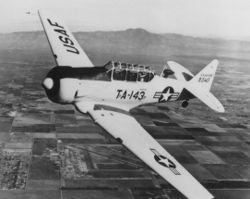![]() The Pacific War Online Encyclopedia
The Pacific War Online Encyclopedia
|
| Previous: T-1 Class, Japanese Landing Ships | Table of Contents | Next: T-101 Class, Japanese Landing Ships |

North American T-6
Texan
| Crew | 2 |
| Dimensions | 29'6" by 42' by 11'8" 8.99m by 12.80m by 3.56m |
| Weight | 4158-5300 lbs 1886-2400 kg |
| Maximum speed | 208 mph 335 km/h |
| Service ceiling | 21,500 feet 6550 meters |
| Power plant | 1 550 hp (410 kW) Pratt and Whitney R-1340-AN1 radial engine driving a two bladed propeller. |
| Armament | Optional 0.303
machine guns in one or both wing roots
or the rear cockpit. |
| External stores | Light bombs for training purposes |
| Range | 750 miles 1210 km |
| Production | 15,109 by North American and 2610 by Noorduyn of Canada (1938-1945) |
| Variants |
Navy variants were designated
the SNJ and those with a C suffix had a tail hook for carrier training. There were numerous variants, some of partially wooden construction, and with different instrument layouts. |
North American's
T-6 Texan was
the most heavily produced trainer
aircraft during the Pacific War, and the vast majority of Allied
pilots-in-training
logged hours in it. Variants of the T-6 were built around the
world, including
even a Japanese
version
codenamed "Oak".
The design was based on the NA-16, which first flew in
April 1835. This was further developed with the NA-26 in 1937, which
had retractable landing gear and an R-1340 Wasp engine. The BC-1
("Basic Combat") trainer first flew in February 1938 and went into
production for the Army Air Corps. The Navy asked for a metal fuselage
version (BC-1A) and the Army and Navy versions were merged in the AT-6
of 1940.
References
The Pacific War Online Encyclopedia © 2007, 2009 by Kent G. Budge. Index